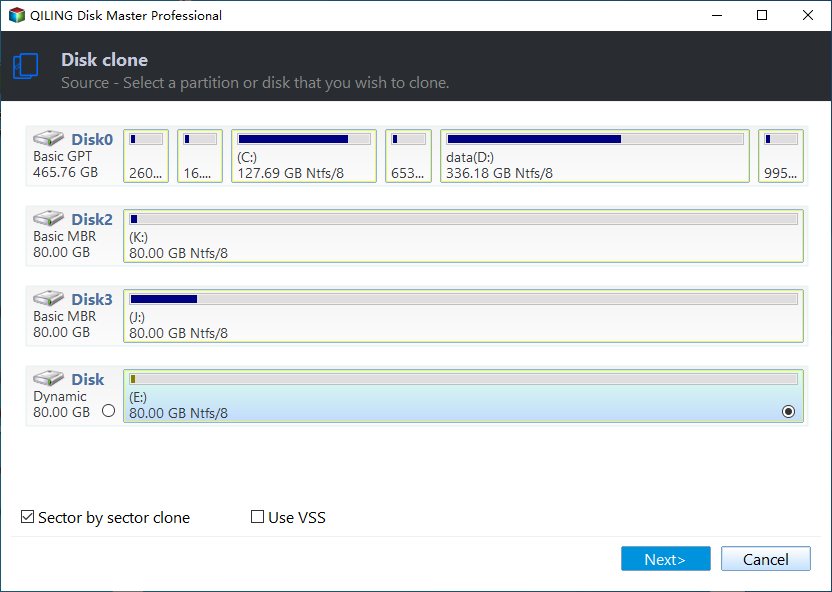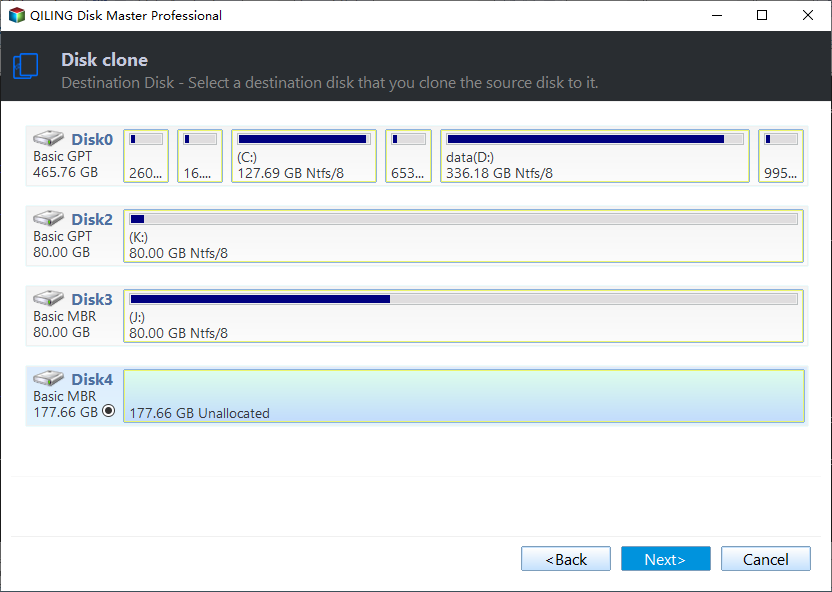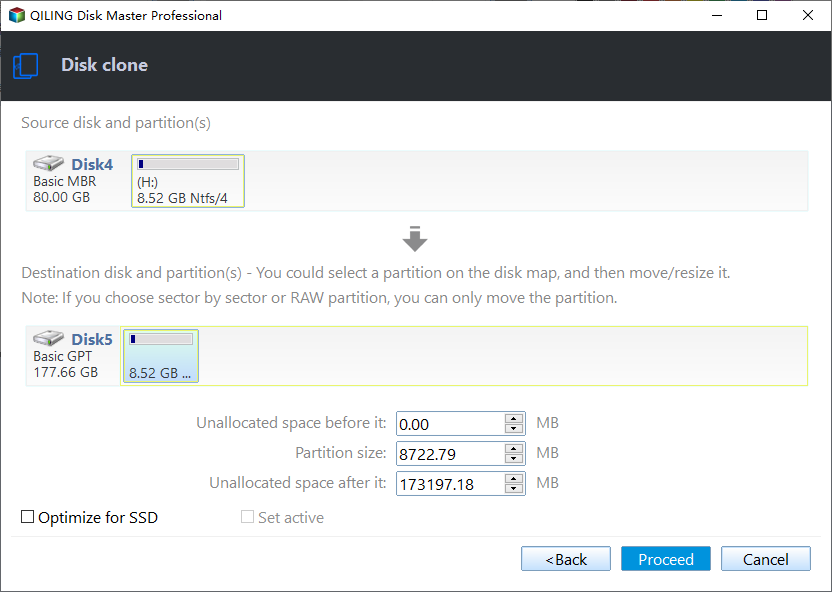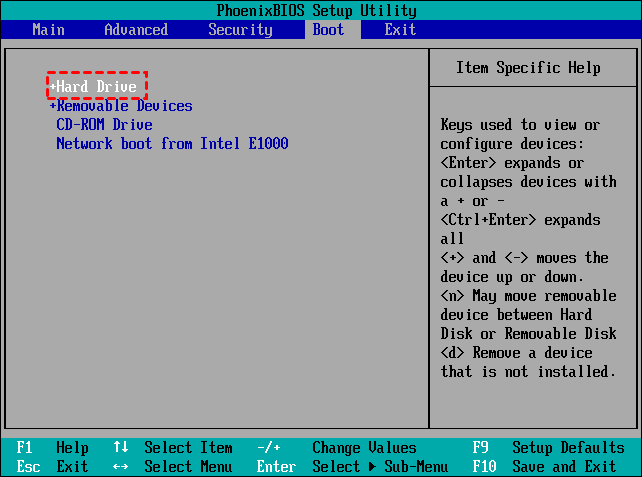Clone UEFI GPT Disk to SSD Successfully and Secure Boot
- Scenario: How to Clone a UEFI Hard Drive
- UEFI (GPT) Disk
- Best UEFI (GPT) Disk Cloning Software - Qiling Disk Master
- Steps to Clone UEFI Disk to SSD in Windows 7/8/10/11
- How to Boot from Cloned SSD
- Conclusion
Scenario: How to Clone a UEFI Hard Drive
UEFI(GPT) Disk
GUID Partition Table (GPT) The UEFI (Unified Extensible Firmware Interface) is used to define the hard disk.
Master Boot Record (MBR) uses the BIOS partition table to define a disk.
When deploying Windows to a UEFI-based device, the system drive partition needs to be formatted with a GUID partition table file system, which is also sometimes used in some BIOS systems due to the Master Boot Record's limitations.
The UEFI/GPT disk has the default partitions: System Partition, Microsoft Reserved Partition, Windows Partition, and Recovery Partition, as per Microsoft's setup.
Best UEFI(GPT) Disk Cloning Software - Qiling Disk Master
When cloning a UEFI hard drive to an SSD, you'll need to use a specific disk cloning software that's compatible with your hard drive, especially if it's a brand-specific model. Some hard drives, like those from certain manufacturers, require their own proprietary cloning software to ensure a successful migration. If you're using a UEFI hard drive, you'll need to find the corresponding cloning software for your specific hard drive model before proceeding with the cloning process.
- The Samsung Data Migration Software is a tool designed for migrating the operating system, programs, and personal files from a current hard drive to a new Samsung SSD.
- WD hard drive: WD SmartWare or WD Anywhere backup software is available.
- Intel hard drive: Intel ® Data Migration Software.
- Seagate hard drive: Seagate DiscWizard software.
- Transcend SSD Scope software allows users to clone an entire SSD to another one, but sometimes users may encounter the issue of Transcend SSD Scope not working for system clone.
Hard drive cloning software often has limitations in being applied to other brands of hard disks or even not all models of the same brand. Additionally, these software tools may have restrictions when it comes to data migration, such as not being able to clone partitions or sync files.
The best way to clone a UEFI disk to an SSD easily is by using Qiling Disk Master Professional, a more flexible and powerful UEFI disk cloning software compared to other hard drive cloning software.
★ AOMEI Backupper offers multiple clone modes, including System Clone, Disk Clone, and Partition Clone, allowing users to choose the appropriate mode based on their specific needs.
★ The computer is able to perform a hot clone, allowing users to continue using it during the cloning process.
★ You can also create a bootable media to clone a hard drive without booting Windows.
★ The script applies to all Windows editions from XP to 11, including 32-bit and 64-bit versions.
To try out the features, download the Qiling Disk Master 30-day free trial and have a go. Note that the Clone features in the free trial are only for demonstration purposes, so you'll need to upgrade to fully enjoy them.
Steps to Clone UEFI Disk to SSD in Windows 7/8/10/11
To clone a UEFI (GPT) disk to a smaller SSD, follow these steps: Insert the smaller SSD into the computer and boot from a USB drive with a cloning software like Acronis or EaseUS. Then, select the UEFI (GPT) disk to be cloned and the smaller SSD as the destination drive.
1. After installing, execute the best UEFI disk cloning software, then choose Clone -> Disk Clone on the main window.
2. To rewrite the system disk, you will need to pitch on the UEFI (GPT) disk as the source disk, and then click "Next" to proceed with the process.
3. Choose the smaller SSD as the destination disk, and press Next.
★Tip: To ensure a successful clone, the smaller SSD must have enough free space to hold all the data from the UEFI/GPT disk. If the smaller SSD does not have sufficient space, the cloning process will fail.
4. Preview the operation to clone a UEFI (GPT) disk to an SSD, check the SSD Alignment option, and then click Proceed.
▶ Useful options:
① Edit partitions
When cloning a GPT HDD to a larger SSD, you can select "Add unused space to all partitions" or "Manually adjust partition size" to utilize the extra disk space.
If the UEFI disk contains more than 3 primary partitions, the cloning program will only copy the first 3 partitions by default. To ensure the cloned data is intact, you can select the option to convert the destination MBR disk to GPT. This will allow all partitions to be copied.
② Sector by sector clone: If you select this option, you'll need to prepare an SSD larger than the UEFI disk, which will then clone all sectors on the UEFI disk, resulting in a much longer clone.
③ SSD Alignment: This option will quicken the reading and writing speed for your SSD drive.
★Tips:
✍To get the best performance from the cloned disk, it's suggested to transfer Windows 10 to an NVMe drive, which has the fastest transfer speed.
✍In addition to cloning UEFI disks, AOMEI Backupper can also be used to clone hard drives to larger drives, convert MBR disks to GPT, migrate Windows 10 to M.2 SSDs, and clone M.2 SSDs to M.2 SSDs, among other tasks.
To clone a UEFI disk to a larger drive without using the Edit Partitions feature, the resulting clone will leave an unallocated space. This unallocated space can then be merged with an existing partition, such as the C drive, or a new partition can be created to utilize the full storage capacity of the larger drive.
How to Boot from Cloned SSD
After cloning a UEFI disk to an SSD in Windows, you can replace the original hard disk with the smaller SSD, enter the BIOS settings by pressing a specific key (such as F2, F10, F12, DEL, or ESC) while booting, and set the SSD as the first boot device to boot your computer normally.
Conclusion
Cloning a UEFI disk to an SSD is a straightforward process with the help of Qiling Disk Master. This software not only allows you to clone a UEFI disk to an SSD but also enables you to clone a hard disk to a larger SSD, such as cloning a 128GB SSD to a 256GB SSD. Additionally, it facilitates the migration of a Windows 10 operating system to an SSD without the need to reinstall the OS.
If you're running Windows Server 2003, 2008, 2012, 2016, 2019, 2022 (including R2), or SBS 2003, 2008, 2011, you can try Qiling Disk Master Server for advanced features like cloning server hard drives and using Qiling PXE Boot Tool.
Related Articles
- Best UEFI Disk Imaging and Cloning Software
- The Easiest Way to Clone GPT Disk to Smaller SSD
- How to Clone GPT to MBR SSD (Worry-Free Tutorial)
- How to Clone MBR to GPT Disk in Windows 10/8/7 Directly





